Renishaw: Global Solutions Centres offer end-users an alternative route to develop new metal AM applications
This year the UK’s Renishaw plc will further expand its global network of Solutions Centres for metal Additive Manufacturing. The centres are designed specifically to provide a secure environment for end-users to trial the company’s metal powder bed fusion technology and establish the viability of a project before committing to major capital investments. Metal Additive Manufacturing magazine’s Nick Williams reports on a recent visit to Renishaw’s flagship Solutions Centre in Stone, Staffordshire. [First published in Metal AM Vol. 2 No. 1, Spring 2016 | 15 minute read | View on Issuu | Download PDF]
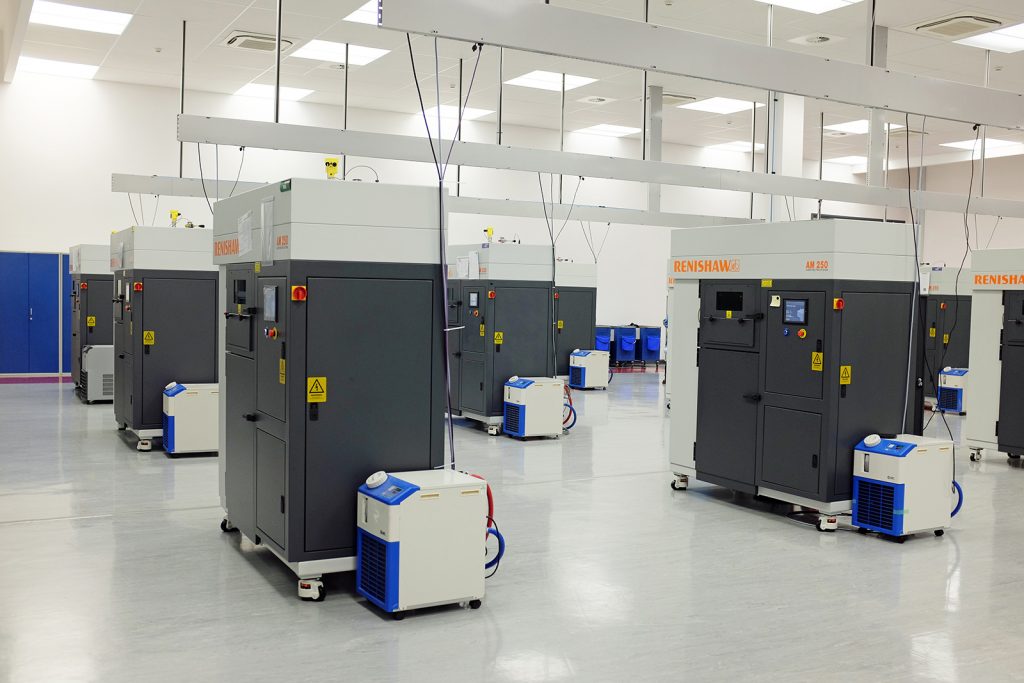
Headquartered in Wotton-under-Edge, Gloucestershire, UK Renishaw plc is one of the world’s leading engineering, science and technology companies, with more than 70 offices in 35 countries employing over 4,000 people. The company is also an established and high profile metal Additive Manufacturing machine manufacturer.
It was following the acquisition of MTT Technologies Ltd (MTT) in April 2011 that Renishaw made the move into metal AM equipment production. Upon completion of the acquisition MTT was incorporated into a new Additive Manufacturing Products Division at Renishaw with a specific focus on the development and further commercialisation of metal AM technologies. MTT’s heritage stretches back to the earliest days of the commercial development of metal AM with the first sales of systems in the UK in 2004. Since the acquisition the division has grown from 35 staff to over 250 AM employees.
The acquisition of was billed as a natural fit for Renishaw, most notably because of the company’s leading market position in the world of metrology and process control, both complementary and necessary areas of expertise for anyone looking to enter the market for metal AM component production. At the time of the acquisition, Renishaw was already a user of AM technology for the manufacture of dental restorations, bringing both an understanding of the status of the technology and an awareness of its challenges and the potential.
When Metal Additive Manufacturing magazine visited the Renishaw facility in Stone, Staffordshire, in January it was nearly five years since the acquisition and over this period the company’s AM operations have experienced dramatic growth. It was also a year to the day that the company acquired the building that is now home to the Renishaw’s Additive Manufacturing operations. Alongside Stone, the division is supported by a large group of development engineers at the new Renishaw Innovation Centre at Wotton-under-Edge and by software teams in Pune, India, and manufacturing teams in Cardiff, Wales. The Solutions Centre in Stone encompasses the division’s offices and R&D facilities and covers some 9000 m2 of floor space.
The role of Renishaw’s Solutions Centres
Renishaw’s strategy for the development of its AM business is the establishment of metal AM solutions centres worldwide. Whilst not all will be the size of the facility in Stone, they will all serve the common purpose of providing an environment for potential and existing customers to develop and prove the viability of a specific metal AM application in a secure, confidential environment with the close support of Renishaw’s technical experts.
To this end, the Stone facility today operates as a fully fledged metal AM manufacturing and development centre. Walking into the impressive main metal AM production hall is in many regards a glimpse of what one imagines the factory of the future might look like (Fig. 1). In a bright and immaculately clean hall, more than 40 Renishaw metal AM machines are in operation, silently manufacturing parts from various materials including aluminium, steels, superalloys and titanium alloys. Given the production capacity in the hall and the expertise on-site, Renishaw’s Stone facility could rightly be considered as the UK’s largest metal AM facility.
Air quality is monitored to help understand the environmental impact of metal AM operations and powder handling is extremely carefully controlled, with dedicated storage and handling rooms for each material type. Operators, when handling powders, wear advanced protective masks with powered air filtering systems for protection from powder inhalation.
Explaining the motivation behind the Solutions Centre programme, which will see a number of additional locations opening up worldwide this year, Robin Weston, Marketing Manager for Renishaw’s AM operations, (Fig. 2), stated, “For companies who want to be able to manufacture a small number of components by metal AM, a service bureau can be a cost effective solution. However, if your aim is to move towards developing in-house AM production facilities, then by using a service bureau you may only learn a limited amount about how jobs are completed. Our Solutions Centres, on the other hand, aim to address this by allowing potential customers to use our software, production equipment and testing facilities over an extended period whilst working in close collaboration with our in-house experts.”
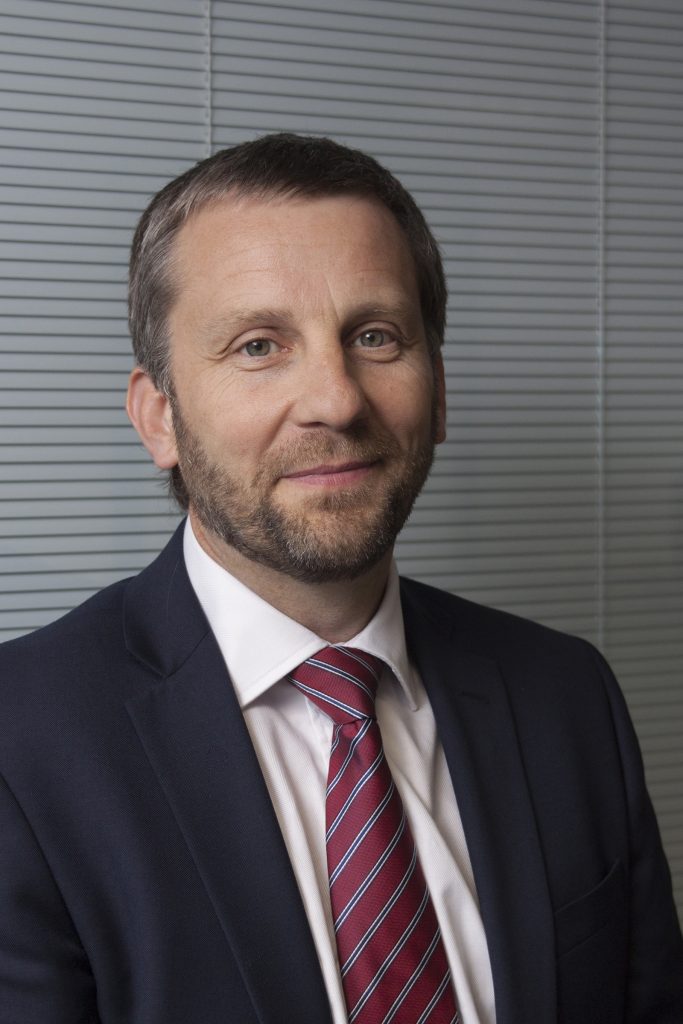
“Solutions Centres offer a way to build up your knowledge of the AM process, whilst at the same time moving potential applications closer to commercial production. At the end of the process, you can make an informed investment in AM systems knowing that they can meet your requirements. Within the Solutions Centre there is a pre-production facility that customers can use once the initial development work is complete, whilst in parallel seeking or developing an alternative supply chain,” stated Weston. “R&D activities can of course be undertaken in collaboration with researchers at university centres but there is always the challenge of competing for precious machine time with other projects. In our solutions centres, the large numbers of machines available can ensure that customer projects are completed within the agreed time, budget and quality expectations. Choosing an approach will depend on the scope of the project. We often work in close cooperation with Universities and customers to combine fundamental research with application expertise to achieve a successful outcome.”
In addition to the main manu-facturing hall, an extremely well-equipped laboratory supports the projects undertaken at the Solutions Centre (Figs. 3 and 4). The laboratory includes SEM with EDS, high resolution optical microscopy, a state of the art Renishaw Equator gauging system, abrasive cutters and polishing equipment for optical and microstructural analysis, density and hardness testing systems and tensile testing facilities. Powder testing includes Hall flow for powder flowability, a powder rheometer for flow characteristics, a particle size analyser and a powder blender. A vacuum furnace is also installed and there is also a dedicated area for the removal of components from build plates and subsequent machining operations. Dedicated private offices and meeting facilities are also available for customers to use whilst on-site that include separate secure computing facilities.
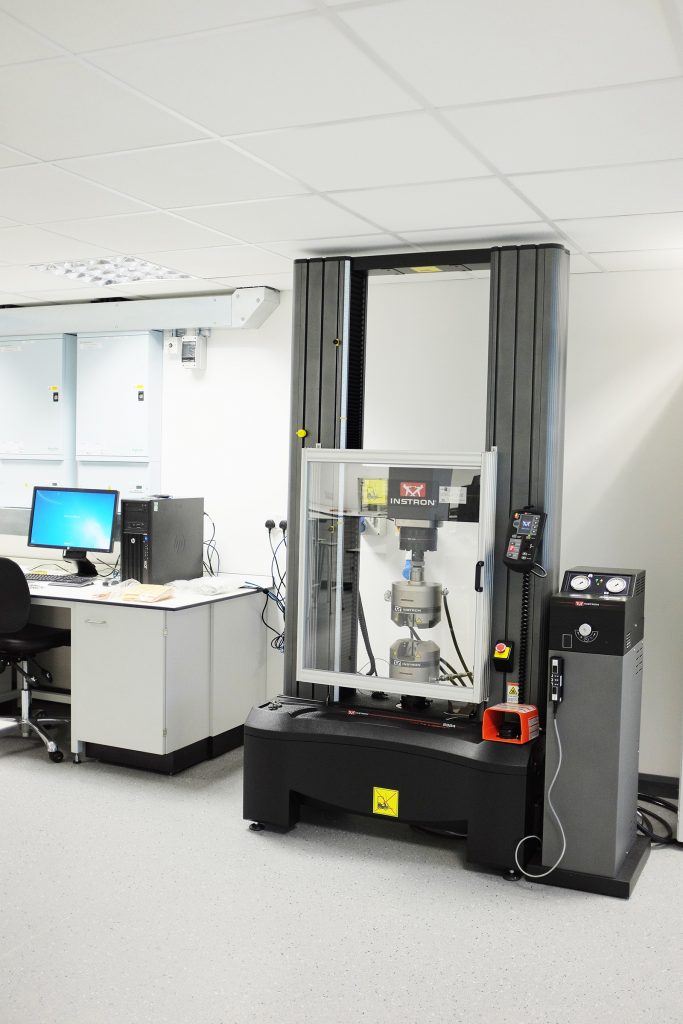
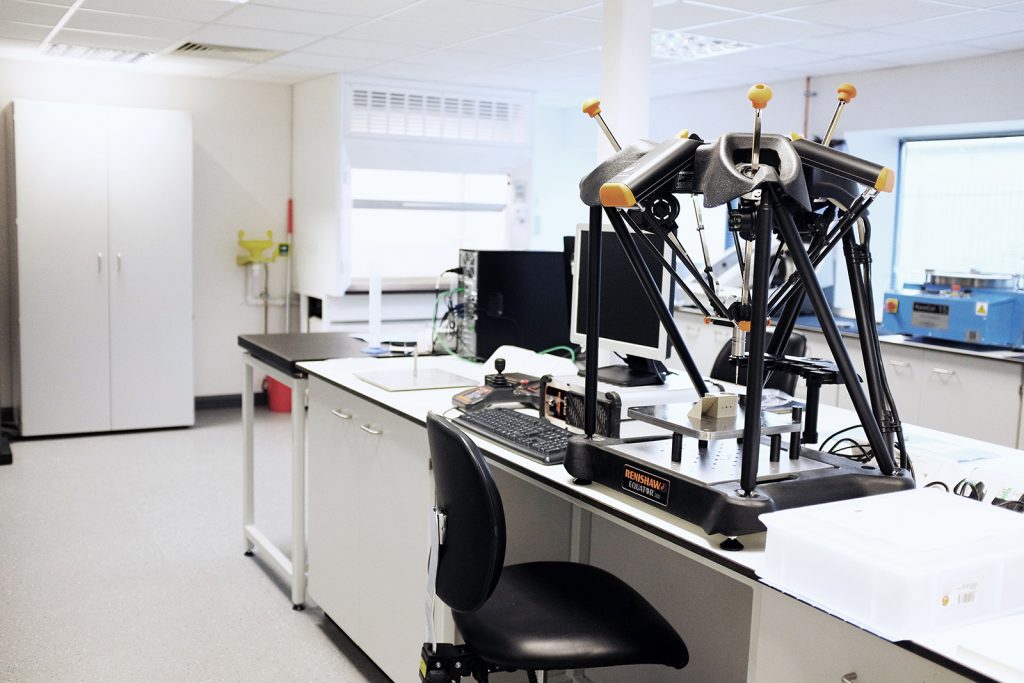
Commenting on the benefits of working closely with Renishaw’s customers in such an environment, Weston stated, “The work undertaken at our Solutions Centre also gives us tremendous insight into the needs of our customers and the challenges that those new to this technology face. By being able to work in partnership on the development of a project, further opportunities for the application of metal AM in their business can be identified, thereby increasing AM’s applications and market share.”
In addition to the centre in Stone, Renishaw also has additional UK Solutions Centres in Bristol and Cardiff. Additional locations due to be opened during 2016 include Stuttgart in Germany, Dallas and Chicago in the US, Toronto in Canada, and Shanghai, China. The company’s first Indian Solutions Centre has already opened in Pune.
Renishaw’s AM machine range
The workhorses of Renishaw’s AM range are the AM250 (Fig. 7) and AM400 systems. Both machines have build volumes of 250 mm × 250 mm × 300 mm, however whilst the AM250 has a 200 W laser the AM400 has a 400 W laser. Both systems have evolved from their initial configurations with enhancements that include larger filters, improved control software, revised gas flow and window protection systems. Both systems have a beam diameter of 70 micron ensuring the transferability of existing 200 W parameters to the 400 W system.
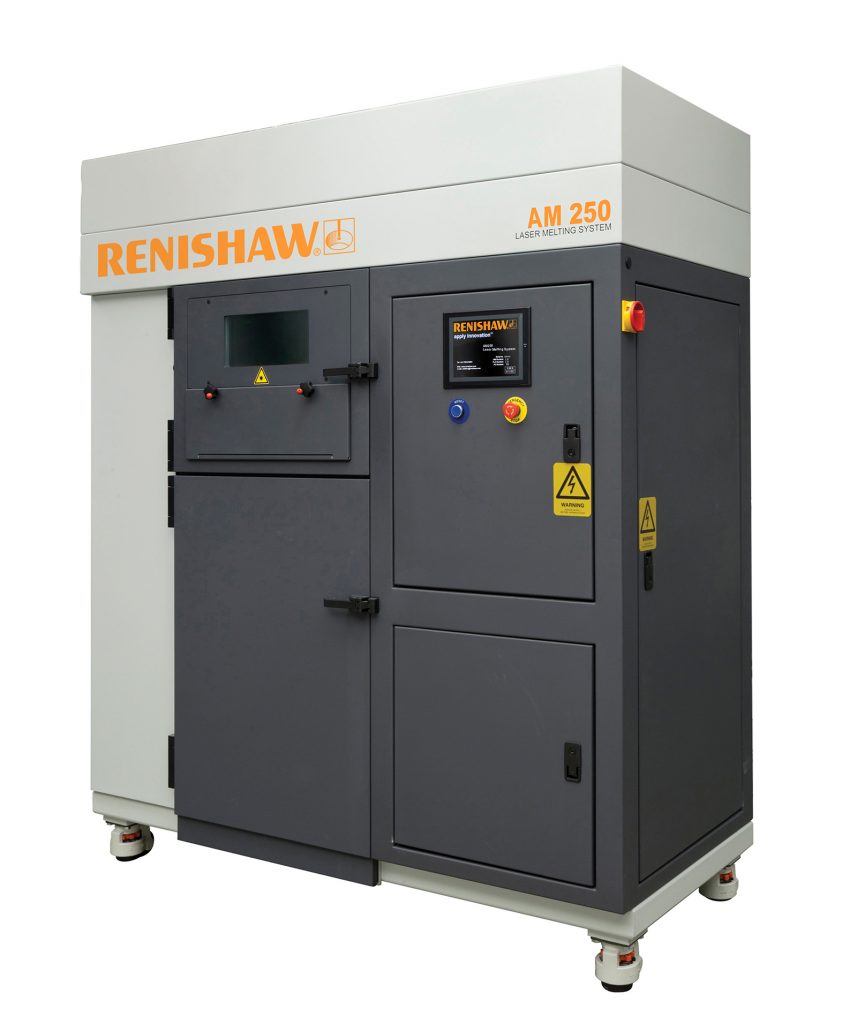
Renishaw’s most significant machine launch since entering the market for metal AM systems is, however, its new RenAM 500M system (Fig. 8). As well as allowing an increased z-axis travel of 350 mm, the RenAM 500M has been specifically developed for the industrial production of metal AM parts. Upgraded to include a 500 W laser, the system features automated powder and waste handling systems to enable consistent process quality and reduced operator interaction.
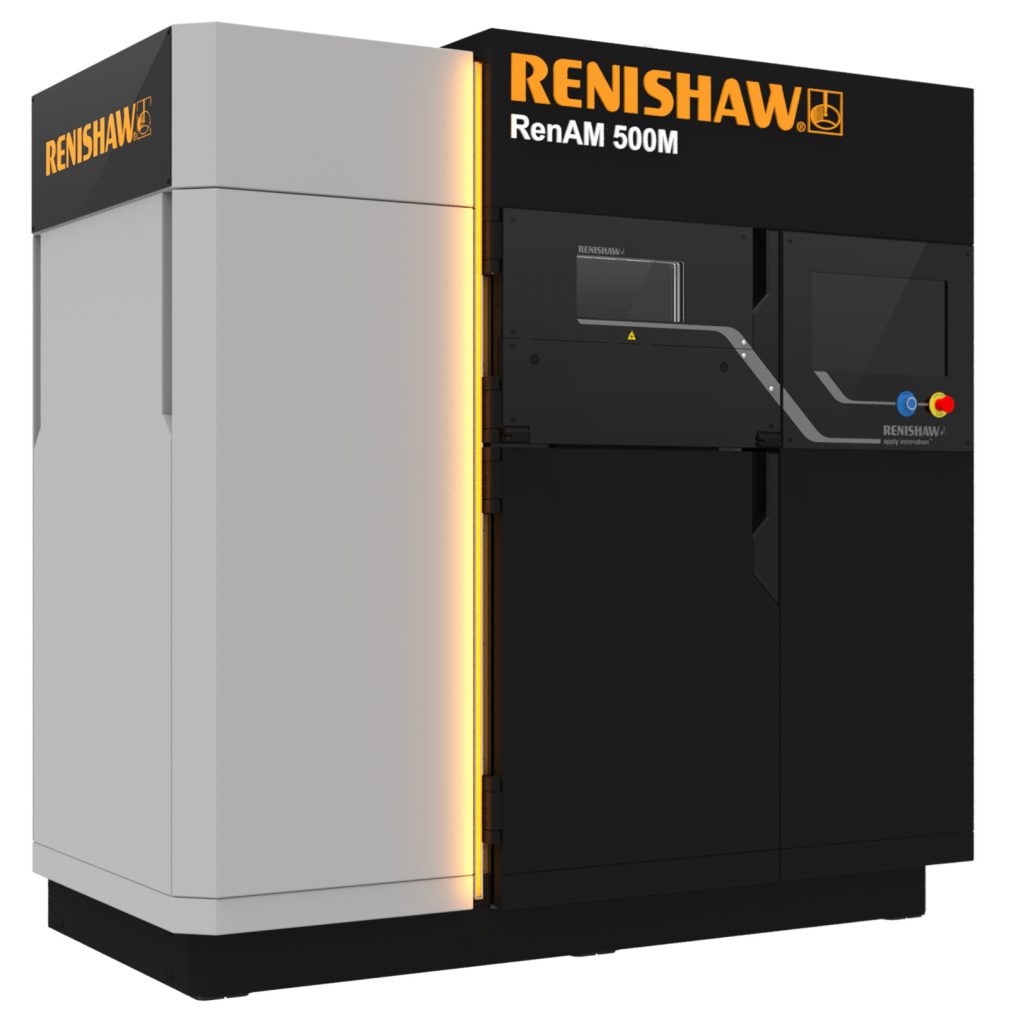
Weston told Metal AM magazine, “A major difference between our AM250 and the RenAM 500M is that the majority of systems in the machine are developed in-house, in contrast to the AM250’s extensive use of off-the-shelf components. This has not only offered far greater development flexibility, but also enabled increased in-house quality control.”
“In addition to their technical capabilities, the concept and design of AM machines is evolving to meet the ever more sophisticated requirements of end-users. Our machines have a footprint that is as compact as possible in recognition of the fact that these machines are frequently used in high cost economies where space is at a premium. They are also being designed to make all operator intervention as efficient as possible. A simple example in the case of the RenAM 500M was to move the powder loading system to waist height, rather than at the top of the machine as on earlier models. The ultimate goal is to move to full automation, but to achieve this effectively it is our belief that this will require significant further advances in process understanding,” added Weston.
In an area adjacent to the main metal AM parts production hall in Stone is the development and testing area for new models of Renishaw’s AM machines. Commenting on the current machine range and future machine developments, Weston stated that whilst the company is developing new multi-laser systems and systems with the next generation of process monitoring capabilities, it is not in the company’s nature to rush such important developments to market. “We will not launch such a system until it is has been thoroughly tested and evaluated. As a major international technology company operating in a wide range of markets, we have a hard built reputation to protect.”
Whilst most product development takes place in Stone, research and development is conducted across multiple sites where the relevant expertise exists, such as optical engineering, software, process and motion control and many other disciplines. The manufacture of the company’s AM machines takes place at the 775,000 m2 Miskin site, near Cardiff, South Wales.
Italy: A success story in Metal AM
Whilst Europe as a whole is a major market for Renishaw’s AM division, Italy is regarded as somewhat of a pioneer in terms of metal AM technology adoption and as such is a regarded as a unique market for Renishaw. The company’s Enrico Orsi, Product Manager Italy, told Metal AM magazine, “Whilst Italy is a very active country in industrial and medical AM, some very large players for aerospace and energy already have manufacturing sites. A surprisingly high number of medical implants are additively manufactured and of course we host some of the world’s most important motor racing teams. All of this is backed up by a history of excellence in manufacturing technology that places the country as the fourth largest machine tool manufacturer worldwide and one of the top in terms of machine usage, with over 300,000 metal working machines installed in machine shops around the country.”
Orsi added, “With this background the expectations for the growth of Additive Manufacturing cannot be anything other than really positive and recent sales figures confirm this. In Italy we have a firm position in the metalworking business, not only with Additive Manufacturing technologies but also with Renishaw’s other technologies that provide the link between the different stages that bring a product to life, from metal powder supply through to post-build inspection, machining setup, inspection and post-process certification. In this sense we’re ideally placed to support the typical Italian mid-size machine shop, which likes to maintain the entire process in house to offer premium service to its customers.”
Concluding, Orsi stated, “We’re facing strong competition in Italy, no doubt. However, the whole sector is thriving. Renishaw in particular has advantages in terms of low entry barriers and significant application support, which are extremely important to new companies trying to integrate Additive Manufacturing in their machine shops and factories. The core of the Italian manufacturing sector is built on small and medium enterprises and the factors above are extra important for this type of companies, making us even better placed.”
The potential for metal AM in China
Renishaw has performed strongly in China in recent years across all its product ranges and the country remains the biggest market for Renishaw PLC. Jiandong He, AM Application Manager for Renishaw in China, continues to see great potential for AM technology in China.
“The industry and the market trends are more or less the same as in Europe and the US, especially for the lower technical level AM adopters. The number of senior customers with a higher level of expertise is, however, comparably less. There is limited understanding of how to design or optimise products for metal AM, or how to combine metal AM with conventional processes in solutions for aerospace, medical and tooling applications,” stated He.
He also believes that expectations for metal AM in China are too high. “AM can’t just be used with the expectation of getting equal or better performance compared to traditionally designed products unless there is significant topology optimisation and a re-design for weight reduction and improved mechanical properties.”
Renishaw has high hopes that the nature of the services offered in its new Shanghai Solutions Centre will go a long way towards managing technology expectations and increasing process knowledge in this key global market.
Metal powder solutions
Renishaw, in line with other machine makers, also supplies metal powders to its customers. Whilst powders are not typically manufactured by the machine makers, powders are specified and qualified to guarantee optimum performance in a manufacturer’s system. Commenting on the use of third party powders Weston stated, “Powders for AM have to meet very specific requirements and have to offer consistent properties from batch to batch. Any variation in powder size distribution or chemical composition will directly impact the stability of the process and the properties of the finished product. We therefore naturally encourage the use of our own certified powders in the development of new applications. Some experienced customers, in particular customers with a well equipped metallurgical department, are naturally in a strong position to experiment with powder from other sources and have the capability to do the necessary testing, analysis and classification of the incoming powder themselves, or with support from Renishaw as required.”
One area of research at Renishaw is understanding the impact of recycling on metal powders. Weston stated, “We monitored the powder and mechanical properties of twenty builds in which a single batch of powder was used. After every build the unmelted powder in the overflow and build volume was sieved and returned to the hopper for the next build. Unused powder left in the hopper after each build was not disturbed. We found that there was very little change to the powder chemistry [interstitials] and tensile properties over the progression of the re-use. Component density was consistently measured at 99.9% through all the builds. Data from a more rigorous version of this experiment is currently being analysed.”
“It’s important to note, however, that an aspect such as chemical composition is very much dependent on atmosphere control in the AM machine and this can vary significantly from manufacturer to manufacturer,” added Weston.
Looking ahead
Whilst Metal AM technology has advanced dramatically in recent years, the process currently remains relatively slow and labour intensive, with limited useful process control capabilities. The industry is, however, continuing to move in the right direction at pace with a view to optimising the process for commercial production.
“The key to this is automation, however, effective automation requires advances in process control and monitoring to improve quality and repeatability,” commented Weston. “A priority for the industry will be a major advance in software for AM. Integrated software tools need to be able to take the end-user from the CAD drawing to the finished component, including topology optimisation, the generation of support structures and quality control. A more connected process chain will be far more advantageous and bring huge benefits down the line.”
In many cases the individual software components for each step exist or are in an advanced stage of development. QuantAM (Fig. 10), Renishaw’s own dedicated build preparation package, provides a selection of tools for file preparation. “We have considerable software development experience and there are around 300 employees dedicated to software development within the company, so this area isn’t new to us. We believe that this is just one aspect of our business that sets us apart from other AM technology developers,” commented Weston.
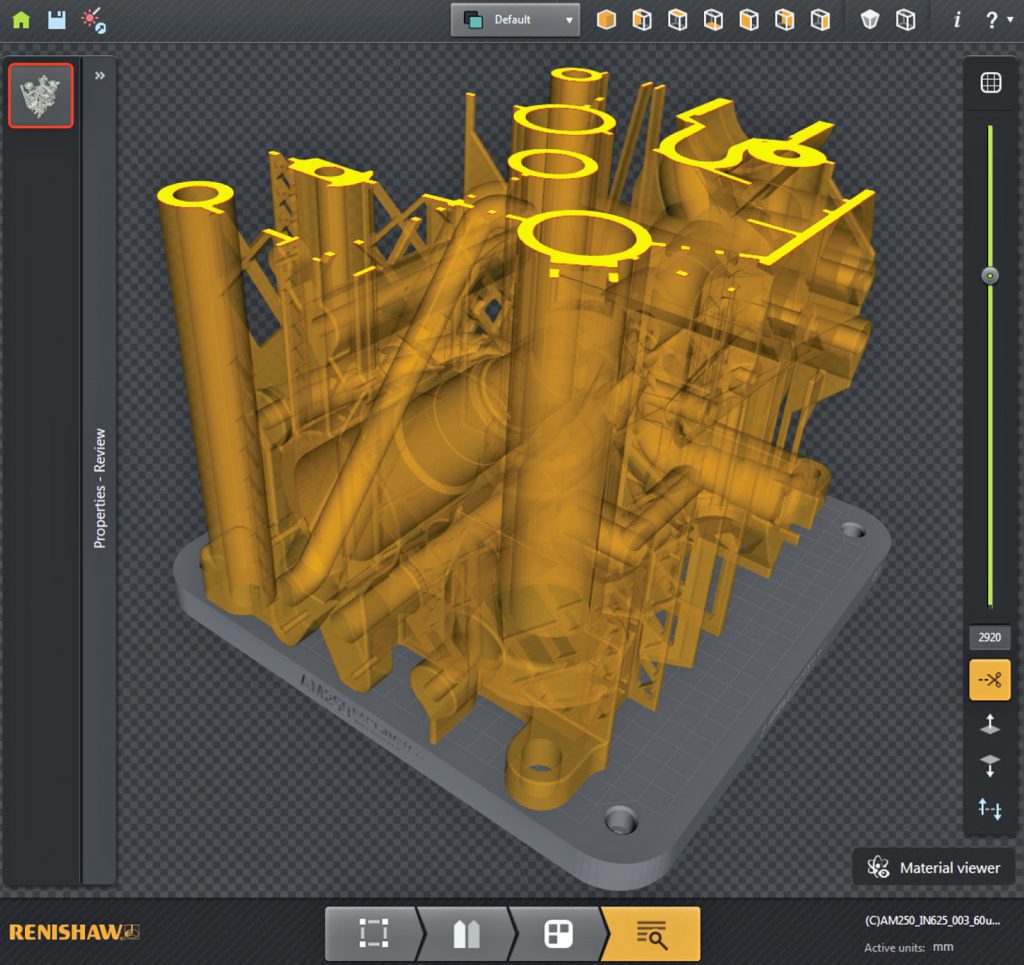
It was also stated that another pressing challenge is that of education and training. “What is clear to us is that the skills ecosystem is too small. Training for the development of AM needs to move from high level research to practical industry-oriented training that can help support the growth of the industry.” Renishaw is developing and maturing its customer education and training programmes for AM technologies to support subsidiaries and customers.
Contact
Robin Weston
Marketing Manager, Additive Manufacturing Products Division
Renishaw plc
Brooms Road, Stone Business Park
Stone, Staffordshire, ST15 0SH, United Kingdom
Tel: +44 (0) 1785 28 5000
Email: [email protected]
www.renishaw.com







